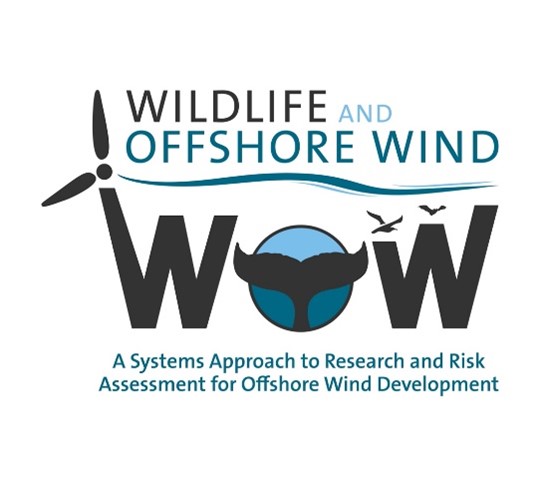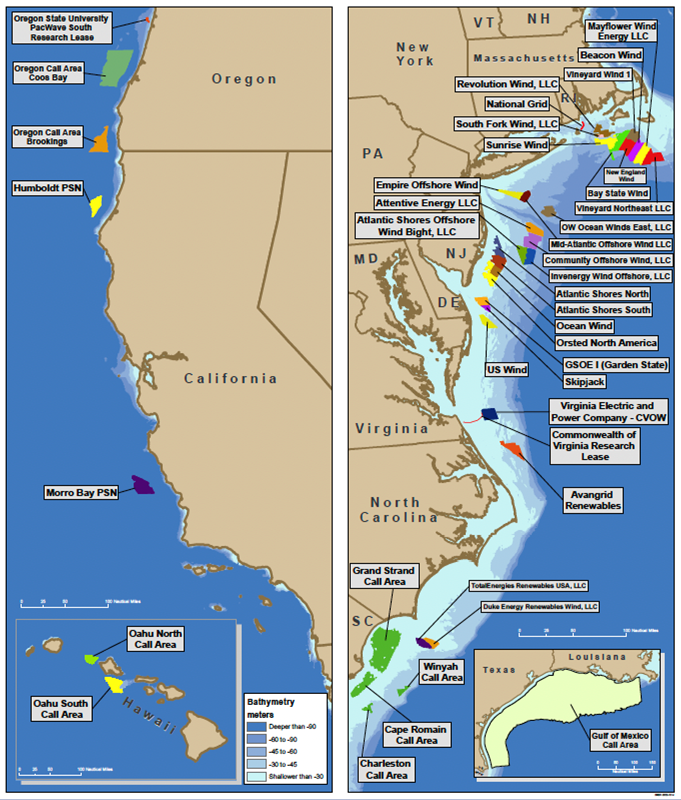
Offshore wind (OSW) energy is on track to expand rapidly in the U.S. Atlantic, but the potential impacts of siting, construction, and operation on the local wildlife are not well known. There are sizable gaps in knowledge about the behaviors and movements of some species in the surrounding habitats.
In support of the Biden Administration’s goal to deploy 30 gigawatts of OSW energy by 2030 (Figure 1), the Department of Energy’s Wind Energy Technologies Office recently announced $13.5 million for four projects co-funded by the Bureau of Ocean Energy Management to provide critical environmental and wildlife data to assist responsible OSW development. As part of that effort, Duke University is leading the Wildlife and Offshore Wind (WOW) project, which aims to address data gaps and develop geospatial mapping tools, conservation technologies, and operational practices that identify and protect species that might be at risk. The WOW project’s goal is to provide a long-term roadmap for efficient and effective assessment of the potential effects of OSW energy development on birds, bats, marine mammals, and sea turtles. The multidisciplinary team includes researchers from universities, national laboratories, consulting firms, and non-profit organizations.
Duke University is working collaboratively with fourteen other institutions and organizations on the WOW project, including the University of St. Andrews, Syracuse University, Florida State University, the Wildlife Conservation Society, the New England Aquarium, Woods Hole Oceanographic Institution, Cornell University, the Biodiversity Research Institute, Southall Environmental Associates, Scientific Innovations, Pacific Northwest National Laboratory, the State University of New York at Stony Brook, and Rutgers University. The team is led by Duke faculty members Drs. Doug Nowacek, Pat Halpin, and Brian Murray, and WOW collaborates with the Regional Wildlife Science Collaborative for Offshore Wind and is advised by an external advisory board.

Figure 1. Maps of U.S. outer continental shelf and areas of potential wind development as identified by the Bureau of Ocean Energy Management (BOEM) (maps from BOEM website “Outer Continental Shelf Renewable Energy”, June 2022).
Working over a five-year period, the WOW team is identifying knowledge gaps, prioritizing research efforts, and conducting studies as the construction of OSW farms starts along the Atlantic Coast of the U.S. (Figure 1). Research is primarily focused in two study sites, one off the coast of Massachusetts and Rhode Island and the second off the coast of New York and New Jersey, representing areas with significant planned OSW development. The team will use multiple data collection techniques to create a comprehensive view of the effects of OSW development on wildlife. Species of interest include:
- Seabirds (e.g. Northern Gannets, Great Black-backed Gulls, Herring Gulls, Red-throated Loons) – GPS transmitters will be used to monitor migratory birds.
- Bats (e.g. Eastern red bat) – Researchers will deploy acoustic recorders on offshore platforms to quantify the spatiotemporal patterns of bat species in the area.
- Marine mammals (e.g. North Atlantic right whales, Fin whales, Sei whales, Minke whales, Humpback whales) – To assess potential marine mammal displacement and changes in behavior, the team will use a combination of tagging techniques, aerial surveys, and passive acoustic monitoring.
- Sea turtles (e.g. Loggerhead and Leatherback) – Aerial and vessel surveys will be the primary techniques for collecting data on sea turtles.
Data collected during the project will fill in research gaps and direct regional ecosystem studies (Figure 2). This approach will support predictive modeling forecasts to understand how OSW development may impact wildlife in the long term. All data and information will be made publicly available on Tethys and other PRIMRE knowledge hubs.

Figure 2. The WOW project’s research approach and risk assessment.
Upon completion of this project, the OSW industry, federal government, and stakeholders will have a set of integrated frameworks (e.g., Occurrence, Exposure, Response, Consequence [OERC], Population Consequences of Disturbance [PCOD]) for local and regional environmental impact assessment. This adaptive roadmap and science-based toolkit will facilitate the design, development, and responsible management of OSW energy in the U.S. and elsewhere, leading to informed, consistent wildlife risk mitigation globally. OSW development is just beginning in the U.S., but many other countries have existing wind infrastructure that makes it difficult to assess the effects on wildlife at the population level. Because the WOW project has the opportunity to conduct large-scale population surveys before OSW development, the team’s recommendations and conclusions on impacts and mitigation strategies will be useful to existing OSW farms and can inform environmental decisions of future OSW developments.
